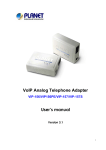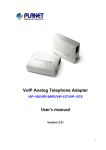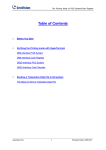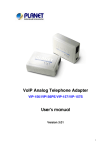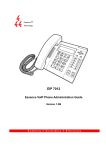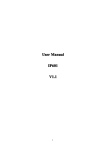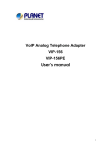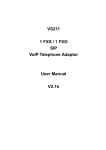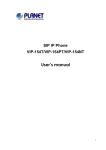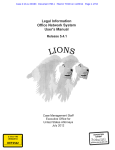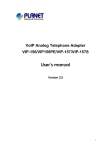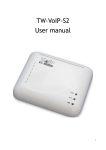Download SIP IP Phone with PSTN spport User`s manual
Transcript
SIP IP Phone with PSTN spport VIP-254NT User’s manual Version 1.0 1 Copyright Copyright (C) 2011 PLANET Technology Corp. All rights reserved. The products and programs described in this User’s Manual are licensed products of PLANET Technology, This User’s Manual contains proprietary information protected by copyright, and this User’s Manual and all accompanying hardware, software, and documentation are copyrighted. No part of this User’s Manual may be copied, photocopied, reproduced, translated, or reduced to any electronic medium or machine-readable form by any means by electronic or mechanical. Including photocopying, recording, or information storage and retrieval systems, for any purpose other than the purchaser's personal use, and without the prior express written permission of PLANET Technology. Disclaimer PLANET Technology does not warrant that the hardware will work properly in all environments and applications, and makes no warranty and representation, either implied or expressed, with respect to the quality, performance, merchantability, or fitness for a particular purpose. PLANET has made every effort to ensure that this User’s Manual is accurate; PLANET disclaims liability for any inaccuracies or omissions that may have occurred. Information in this User’s Manual is subject to change without notice and does not represent a commitment on the part of PLANET. PLANET assumes no responsibility for any inaccuracies that may be contained in this User’s Manual. PLANET makes no commitment to update or keep current the information in this User’s Manual, and reserves the right to make improvements to this User’s Manual and/or to the products described in this User’s Manual, at any time without notice. If you find information in this manual that is incorrect, misleading, or incomplete, we would appreciate your comments and suggestions. CE mark Warning The is a class B device, In a domestic environment, this product may cause radio interference, in which case the user may be required to take adequate measures. WEEE Warning To avoid the potential effects on the environment and human health as a result of the presence of hazardous substances in electrical and electronic equipment, end users of electrical and electronic equipment should understand the meaning of the crossed-out wheeled bin symbol. Do not dispose of WEEE as unsorted municipal waste and have to collect such WEEE separately. Trademarks The PLANET logo is a trademark of PLANET Technology. This documentation may refer to numerous hardware and software products by their trade names. In most, if not all cases, their respective companies claim these designations as trademarks or registered trademarks. 2 Revision User’s Manual for PLANET SIP IP Phone: Model: VIP-254NT Rev: 1.0 (2010, December) Part No. EM-VIP254NTV1.0 3 TABLE OF CONTENTS Chapter 1 Introduction........................................................................... 6 Overview............................................................................................................................6 Package Content ...............................................................................................................7 Physical Details .................................................................................................................8 Front View and Keypad function................................................................................8 Rear View ...................................................................................................................9 Chapter 2 Preparations & Installation .................................................11 Physical Installation Requirement ................................................................................ 11 Administration Interface ...............................................................................................13 Web configuration access: ........................................................................................13 Chapter 3 Network Service Configurations....................................... 14 Configuring and monitoring your IP Phone from web browser ................................14 Overview on the web interface of IP Phone .............................................................14 Manipulation of IP Phone via web browser .............................................................14 LAN IP address configuration via web configuration interface...............................15 Chapter 4 VoIP IP Phone Configurations........................................... 17 Information .....................................................................................................................17 Phone Book settings .................................................................................................18 Speed Dial settings ...................................................................................................20 Dial Plan Settings .....................................................................................................21 Call Service Settings.................................................................................................24 General Setting .........................................................................................................25 WAN Settings ...........................................................................................................26 DDNS Settings .........................................................................................................27 VLAN Settings .........................................................................................................28 VPN (PPTP & L2TP) Settings .................................................................................29 SNTP Settings...........................................................................................................29 NAT Settings.............................................................................................................30 DMZ Settings ...........................................................................................................31 Virtual Server............................................................................................................31 Service Domain Settings ..........................................................................................32 Codec Settings ..........................................................................................................34 Advanced Settings ....................................................................................................35 STUN settings ..........................................................................................................36 Auto Configuration Setting ......................................................................................37 Auto Update Setting .................................................................................................38 4 Update Firmware ......................................................................................................39 Advanced Settings ....................................................................................................40 Password Setting ......................................................................................................42 Tone Settings ............................................................................................................43 Restore Default Setting.............................................................................................43 Language Setting ......................................................................................................43 Save & Reboot..........................................................................................................44 Logout.......................................................................................................................44 Appendix A Voice communications ...............................................................................45 Case 1: Voice communication via SIP IP PBX _IPX-300 ........................................45 Case 2: Call Forward Feature_IP to IP Forward.......................................................46 Case 3: Call Forward Feature_All to PSTN .............................................................48 Case 4: Call Forward Feature_PSTN to IP Forward ................................................49 Case 5: Call Forward Feature_Peer to Peer mode....................................................50 Case 6: Auto Answer Feature_IP to PSTN ...............................................................50 Case 7: Auto Answer Feature_PSTN to IP...............................................................52 Appendix B The method of operation guide ................................................................55 Call Transfer .............................................................................................................55 3-Way Conference ....................................................................................................55 Call Waiting ..............................................................................................................55 Switch the Realm (Registration Proxy Server) ........................................................55 Appendix C VIP-254NT Specifications ........................................................................57 5 Chapter 1 Introduction 1 Overview For a cost-effective and high performance VoIP communications today, PLANET introduces the SIP IP phone, VIP-254NT to fulfill the VoIP deployment needs from ITSP, enterprises to home use. The built-in PSTN interface provides user more convenience between IP Phone and PSTN call selections. The VIP-254NT features high-quality speakerphone technology, and various voice services including an easy-to-use speaker on / off button and call hold / transfer / 3-way conference buttons. The VIP-254NT has additional features such as built-in PPPoE / DHCP clients, password-protected machine management, LCD menu display, speed-dial 3-way conference, hands-free speakerphone, last number redial, incoming message indicator, and user-intuitive web administration system. The VIP-254NT is the SIP IP phone featuring self-contained, service-integrated, intelligent phone features, and powerful voice processing. It can effortlessly deliver toll voice quality equivalent to the regular SIP protocol connections by utilizing cutting-edge Quality of Service, echo cancellation, comfort noise generation (CNG) and voice compensation technology. Meanwhile, the dual Ethernet interfaces on the IP Phone allow users to install in an existing network location without interfering with desktop PC network connections. The VIP-254NT is an ideal solution for office / home use as well as installation for Internet Telephony Service Provider (ITSP). It's the delivery platform for IP voice services that brings benefits from the VoIP technologies in your daily life. Product Features • Simple Installation and administration Configuration of the IP Phone can be performed in minutes via the LCD menu keypad, or web interfaces. Using the built-in LCD display, the IP Phone offers user-friendly configuration guidelines, machine operation status, call status displays, and incoming call identification. • Feature-rich keypad IP Phone The IP Phone integrates a high-quality speakerphone with the Call Hold, Forward, Transfer and Waiting functions and also provides advanced telephone features, such as 3-way conference key, incoming call history indicator in a much more convenient and functional manner than traditional telephone sets. 6 • Dynamic IP address assignment, and voice communication The IP Phone can act as a PPPoE/DHCP client, automatically obtaining an IP address for Internet access. • Various field applications compliant The IP Phone is capable of handling peer-to-peer and SIP proxy / IP PBX registration, authentication to interact with major IP PBX/SIP gateway/IP Phone in the market. The IP Phone offers the most flexibility and interoperability with PLANET and 3rd party VoIP vendors, allowing the deployment of both simple and complex VoIP networks such as ITSP, PC-to-Phone/Phone-to-PC or enterprise VoIP environments. • Standards compliant The IP Phone complies with SIP 2.0 (RFC3261), interoperates with 3rd party SIP voice gateways/terminal/software as well as other PLANET VoIP products. Supported Voice codecs and VoIP technologies are: G.723, G.729ab, G.711u-law/a-law; Voice Activity Detection (VAD), and the Confort Noise Generation (CNG). • Built-in PSTN The built-in PSTN interface provides user more convenience between IP Phone and PSTN call selections easily VoIP Features • SIP 2.0 (RFC3261) compliant • Peer-to-Peer / SIP proxy calls • Voice codec support: G.711, G.723.1, G.726, G.729A, G.729B • Voice processing: Voice Active Detection, DTMF detection/ generation, G.168 echo cancellation (16mSec.), Comfort noise generation • In band and out-of-band DTMF support Package Content The contents of your product should contain the following items: VoIP IP Phone Power adapter Quick Installation Guide User’s Manual CD RJ-11 cable x 1 RJ-45 cable x 1 7 Physical Details The following figure illustrates the front/rear panel of IP Phone. Front View and Keypad function Front Panel of VIP-254NT Keypad Description Menu and all status shall be displayed for users. 1 LCD Display 2 Menu 3 OK 4 Conf Press this button can make conference function. 5 Book Enter the phone book selection. 6 Up↑/ Down↓ 7 Vol + / - To bring out the menu selection while IP Phone is in idle state. To be used as confirm configuration or enter sub-menu. To move the sub-menu selection. To adjust the volume. 8 To be used as 8 Left / Right 9 Call In 10 Dialed Out 11 DND Enable/Disable the DND function. 12 FWD To carry out forward function. 13 Cancel 14 Transfer 15 Call 16 M1~M5 17 Line 1 ~ Line 3 18 Hold 19 PSTN / IP 20 Redial Press to dial the last dialed number when the IP Phone is off-hooked. 21 Hand Free To switch between the usage of the handset and the speaker devices. To check Incoming call To check dialed call To delete the dialing digit To transfer an active call (incoming call answered or outgoing call accepted) to another devices. To sent out the dialing numbers. Users could store their commonly used number in these keys, and call them as speed dial To make 3 line accounts dial call by pressing the Line1 ~ Line 3. To hold the conversation. To switch between IP and PSTN calls. Rear View Rear Panel of VIP-254NT 9 1 DC 7.5~12V DC Power input outlet 2 PC RJ-45 connector, to maintain the existing network structure, connected directly to the PC through straight CAT-5 cable 3 LAN RJ-45 connector, for Internet access, connected directly to Switch/Hub through straight CAT-5 cable. 4 PSTN FXO interface, for connect with PSTN line. Press PSTN/IP button to switch to PSTN mode. LNote Use only the power adapter shipped with the unit to ensure correct functionality 10 Chapter 2 Preparations & Installation 2 Physical Installation Requirement Step 1: Handset Connection Plug Handset Core with Handset and Handset Jack. Step 2: Connecting Power Adapter and Network Plug RJ-45 Cable with WAN port and Switch/Hub ÍNote Use only the power adapter shipped with the unit to ensure correct functionality. 11 Step 3: Computer Network Setup Plug RJ-45 Cable with LAN/PC port and Computer Step 4: Connecting PSTN Line If there is PSTN line, connect it with TEL IN port Step 5: Login Prompt Set your computer’s IP address to 192.168.0.x, where x is a number between 2 to 254 (except 1 where is being used for the IP Phone by default). If you don’t know how to do this, please ask your network administrator.Use web browser (Internet Explorer 6.0 or above) to connect to 192.168.0.1 (type this address in the address bar of web browser). You’ll be prompted to input user name and password: root / null (without password). 12 Administration Interface The IP Phone provides GUI (Web based, Graphical User Interface) for machine management and administration. Key pad administration also available for simple configuration. Web configuration access: To start IP Phone web configuration, you must have one of these web browsers installed on computer for management • Microsoft Internet Explorer 6.0.0 or higher with Java support Default IP address of IP Phone is 192.168.0.1. You may now open your web browser, and insert http://192.168.0.1 in the address bar of your web browser to logon IP Phone web configuration page. IP Phone will prompt for logon username/password, please enter: root / null (without password) to continue machine administration. ÍNote In order to connect machine for administration, please locate your PC in the same network segment (192.168.0.x) of IP Phone. If you’re not familiar with TCP/IP, please refer to related chapter on user’s manual CD or consult your network administrator for proper network configurations. 13 Chapter 3 Network Service Configurations 3 Configuring and monitoring your IP Phone from web browser The IP Phone integrates a web-based graphical user interface that can cover most configurations and machine status monitoring. Via standard, web browser, you can configure and check machine status from anywhere around the world. Overview on the web interface of IP Phone With web graphical user interface, you may have: More comprehensive setting feels than traditional command line interface. Provides user input data fields, check boxes, and for changing machine configuration settings Displays machine running configuration To start IP Phone web configuration, you must have one of these web browsers installed on computer for management Microsoft Internet Explorer 6.0.0 or higher with Java support Manipulation of IP Phone via web browser Log on IP Phone via web browser After TCP/IP configurations on your PC, you may now open your web browser, and input http://192.168.0.1 to logon IP Phone web configuration page. IP Phone will prompt for logon username/password: root / null (without password) IP Phone log in page When users login the web page, users can see the IP Phone system information like firmware version, company…etc in this main page. 14 IP Phone main page LAN IP address configuration via web configuration interface Execute your web browser, and insert the IP address (default: 192.168.0.1) of VIP in the address bar. After logging on machine with username/password (default: root / without password), browse to “Network” --> “LAN Settings” configuration menu: Parameter Description IP address LAN IP address of IP Phone 15 Default: 192.168.0.1 LAN mask of IP Phone Subnet Mask Default: 255.255.255.0 Default Gateway Gateway of IP Phone Default: 192.168.0.254 After confirming the modification you’ve done, Please click on the Submit button to apply settings and browse to “Save & Reboot” menu to reboot the machine to make the settings effective. Connection Type Data required. In most circumstances, it is no need to configure the DHCP Fixed IP settings. DHCP client The ISP will assign IP Address, and related information. The ISP will assign PPPoE username / password for Internet PPPoE L Hint access, Please consult your ISP personnel to obtain proper PPPoE/IP address related information, and input carefully. If Internet connection cannot be established, please check the physical connection or contact the ISP service staff for support information. Save Modification to Flash Memory Most of the IP Phone parameters will take effective after you modify, but it is just temporary stored on RAM only, it will disappear after your reboot or power off the IP PHone, to save the parameters into Flash ROM and let it take effective forever, please remember to press the Save & Reboot button after you modify the parameters. 16 Chapter 4 VoIP IP Phone Configurations 4 Information This page shows the major system information; there are WAN Port, LAN Port, System Information and Register Information. The user could know the network parameters, system firmware version and register status at this page. 17 Phone Book settings IP Phone can set up 140 records of Phone Book. User can make calls via Phone Book feature of IP Phone. Field Phone Book Page Index Name Number Action Description The default is Page 1. It can select Page1 ~ Page 7 to look round Phone Book records. The record number from 0 ~ 139, it can set up 140 records in total. The name of Phone Book records, it only can input numerals. Fill in the outgoing number (Line Number) or IP address. To delete this record. If you need to add a phone number into the Phone Book list, you need to input the position, the name, and the phone number (by URL type). When you finished a new phone list, just click the “Submit” button. 18 If you want to delete a phone number, you can click the “Delete” button at this record. For Example: STEP 1: IP Phone had added the above phone numbers. User press Phone Book button from keypad then the LCD screen will show below: Search: [ 3] STEP 2: Press OK button to enter the Phone Book menu. The LCD screen will show the Phone Book records pervious made. 000 301 001 Brian STEP 3: Selecting the recorder you want to dial and press OK button. It sill show the detail information as below: 202 192.168.0.20:5060 STEP 4: Pick up the telephone handset or press Handfree button to dial to this telephone. IP Dialing.. 1 192.168.0.20:5062 19 Speed Dial settings In Speed Dial setting function you can add/delete Speed Dial number. The 1~5 records are available for M1 ~ M5 Speed Dial buttons, and 6~10 records are reserved at present. You can press the M1 ~ M5 buttons to dial the numbers that set at Speed Dial Setting. If you need to add a phone number into the Speed Dial list, you need to input the name and the phone number (by URL type). When you finished a new phone list, just click the “Submit” button. If you want to delete a phone number, you can click the “Delete” button at this record. Field Description Index The record number from 1 ~ 10 records. Name The name of Speed Dial records. Number Action Pick Up Voice Mail Fill in the outgoing number (Line Number) or IP address. To delete this record. Fill in the pick-up service digits of SIP Server or IP PBX. This field is reserved at present. Fill in the voice mail number of SIP Server or IP PBX. This field is reserved at present. 20 Dial Plan Settings This page defines the Dial Plan Setting function. This function is when you input the phone number by the keypad but you don’t need to press “#”. After time out the system will dial directly. Field Description Drop Prefix The rule of add or replace code. If setup as “Disable”, it will add the prefix number prior to the identification number. If setup as “Enable”, it will replace the identification number. Rule The prefix number. It only accept the numeral and the max length is 8. + The identification number. It can accept the numeral or symbol and the max length is 40. - Symbol: It only accept the [+], [x] 21 - +: It means as “or”. For example, [123+456+334+5xx] even if [123 or 456 or 334 or 5xx] - x: It is equal to 0~9. For example, [5xx] even if the number begin 5. Dial Now If the dialing number are match with this field, it will dial out and need not to press the “#” key to end the dialing. It accepts the numeral or symbol, and the max length are 124. LNote: The starting number can’t be the “0”. For example, if the number is “0xxxx”, because the starting number is “0”, so that the system will ignore this dial plan. Realm 1~5 prefix These options can define the switching code for each Realm No. Auto Dial Time Stop dialing after seconds then send dial number out. Use # as send key If setup as Yes, the system sill stop to receive the dialing number when receive the [#] key. The system also will to determine the Auto Dial Time, it will carry out the calling if there isn’t receive the digit after the Auto Dial Time. If setup as No, the system just according to the Auto Dial Time to determine the end time. Auto PSTN backup Disable Auto PSTN backup options for the phone default. When you set Enable Auto PSTN backup,if the phone registration failed,then the phone is automatically switched PSTN-side. So that you can hear tone from PSTN when pick up the handset. PSTN feature code Besides press the “PSTN / IP” button, it also could dial this number will switch from IP to PSTN mode. Routing Type To select use IP or FXO types for auto routing function, and according to the Routing rule to handle the dialing numbers. Routing rule The rule can delete the prefix number. Descriptions of example: Example_1: Routing to: FXO, Routing rule: 007+009 1. If the dialing number is “00722199518”, it will send the full number for dialing out via FXO port. The real dialing number is [00722199518]. 2. If the dialing number is “00922199518”, it will send the full number for dialing out via FXO port. The real dialing number is [00922199518]. Example_2: Drop prefix: No, Replace rule 1: 002, +: 1234+4321 (No limit the digit length) 1. If the dialing number is start as “1234”, it will add the 002 at begin. The real dialing number is [0021234…]. 2. If the dialing number is start as “4321”, it will add the 002 at begin. The real dialing number is [0024321…]. 22 Example_3: Drop prefix: Yes, Replace rule 2: 006, +: 002+003+004 (No limit the digit length) 1. If the dialing number is start as “002”, it will replace 002 by 006. The real dialing number is [006…]. 2. If the dialing number is start as “003”, it will replace 003 by 006. The real dialing number is [003…]. Example_4: Drop prefix: No, Replace rule 3: 007, +: 5xxx+35xx (Has limit the digit length) 1. If the dialing number start as “5” and follow 3 digits, it will add the 007 at begin. The real dialing number is [0075xxx]. 2. If the dialing number start as “35” and follow 2 digits, it will add the 007 at begin. The real dialing number is [00735xx]. Example_5: Dial Now: *xx+#xx+11x+xxxxxx 1. If the dialing number is match with the rule of “*xx”, it will send out the dialing number directly. For example, *00/ *01/ *02…*99. 2. If the dialing number is match with the rule of “#xx”, it will send out the dialing number directly. For example, #00/ #01/ #02…#99. 3. If the dialing number is match with the rule of “11x”, it will send out the dialing number directly. For example, 111/ 112/ 113…119. 4. If the dialing number is match with the rule of 8 digits, it will send out the dialing number directly. For example, 12345678. LNote If enable the Routing function and the dialing number is match with Routing rule, machine will carry out the Routing function and to skip over the below Drop prefix and Replace rule functions. 23 Call Service Settings You could setup the Call Forward, Hotline, DND and Alarm functions at this page. Field Description Call Forward Settings All All incoming call will forward to the number you chosen. Busy If you are on the phone, the new incoming call will forward to the number you choosed. No Answer If you can not answer the phone, the incoming call will forward to the number you chosen. You have to set the Time Out time for system to start to forward the call to the Forward Type number you choosed. Busy or No If you are on the phone or can not answer the phone, the Answer incoming call will forward to the number you chosen. All to PSTN All incoming call will forward to the PSTN number. No Answer of If you can not answer the phone, the incoming call will PSTN forward to the PSTN number. Forward Number Fill in the forward number. Rings When assign No Answer forward type, the phone will forward to desired number when exceed this ring count. Hotline Settings Hotline Type To enable or Disable the hotline function. Hotline Number When you set hotline number and Enable, on the off-hook state auto dialing your already set hotline number. DND Settings DND Type If set up as “Enable”, the outside caller can’t cll to this phone at the specific 24 time. DND It can set up the disturb t time, 0:0 to 0:0 stand for all the time. Alarm Settings Alarm Type If set up as “Enable”, the phone will ringed up at the specific time. Alarm Time It can set up the system prompt time with 24 hours. General Setting You could setup the Volume, Ringer Type and Auto Answer functions at this page. Field Description Handset Volume To set the volume for you can hear from the handset. Handset Gain To set the volume send out to the other side’s handset. Speaker Volume To set the volume for you can hear from the speaker. Speaker Gain To set the volume send out to the other side’s handset via MIC. Ringer Volume To set the ringer volume. Ringer Type The user can set the tinkle of bells when someone ring your Phone. To select the Ringer Type you wanted. There are four Ringer Types can be chosen. PSTN-Out Volume To set the PSTN volume for you can hear. PSTN-In Gain To set the volume send out to the other side’s handset. Call Waiting When you are talking with other people, You can choose If you want to hear the notice when there is a new coming call. If the call waiting function is On, if there is a new incomeing call, you will hear the call waiting notice in your current call. If you set the function to Off, then 25 you will not hear any notice. Please notice that this option must be disable when want to use the Auto Answer function. Auto Answer There are different incoming call types for flexable applications. The Trunk Gateway function needs to arrange in with the registered Server System. The 3-Party subscribers could make Off-Net call (PSTN) through the PSTN port of VIP-254NT. Auto Answer To set after the ring count met the number you set then the auto Counter answer will enable. PIN Code If you have set the PIN code, the caller will hear a tone to inform to input the PIN Code then the caller can dial out. Please notice that the PIN Code function couldn’t function with Trunk Gateway function together. PIN Code Number The PIN code for auto answer protection. WAN Settings This page defines the WAN setting in this page. Field Description Type The default is Fixed IP, and it also provides DHCP Client and PPPoE connection modes. - Fixed IP: It could setup the IP address manual. - DHCP Client: It will acquire the IP address automatically. - PPPoE: It will use the PPPoE connection method. IP Address To set the IP address 26 Subnet Mask To set the subnet address Default Gateway To set the default gateway address DNS Type The default is Fixed mode, it could setup the DNS mode to manual or auto detection. DNS Server 1 It could setup the first DNS server address. DNS Server 2 It could setup the second DNS server address. MAC ID The MAC of WAN port Host Name The product model DDNS Settings This page defines the DDNS setting in this page. You need to have the DDNS account and input the informations properly. You can have a DDNS account with a public IP address then others can call you via the DDNS account. But now most of the VoIP applications are work with a SIP Proxy Server. When you finished the setting, please click the Submit button. 27 VLAN Settings This page defines the VLAN setting in this page. This function needs to co-operate with network devices which have VLAN function. Field Description VLAN Packets If setup as “Enable”, it could receive VLAN messages. VID (802.1Q/TAG) Dispose VLAN ID is add a Tag header after realize enable the VLAN function. The realized voice packets transfer at the same VLAN. The prerequisite is it must the same as VLAN of upper switch. The value range are 2~4094. User Priority To setup the user priority. (802.1P) CFI To indicate the Canonical Format. - If CFI=1, it means the header label include RIF field, and the NCIF flag valus of RIF will to decide the MAC address is Canonical Format or Non-Canonical Format in frame information. - If CFI=0, it means the header label does not include RIF field, and the MAC address is Canonical Format in frame information. 28 VPN (PPTP & L2TP) Settings The IP Phone has support PPTP and L2TP VPN client connections, the use could choose the VPN type, and input the authorization accounts for VPN connection in this page. SNTP Settings This page defines the primary and second SNTP Server IP Address, to get the date/time information. Also you can base on your location to set the Time Zone, and how long need to synchronize again. When you finished the setting, please click the Submit button. 29 NAT Settings This page defines the PC setting in this page. Field Description LAN Mode The default is Bridge mode, and it also provides NAT mode. - Bridge: When set as is mode, the WAN and LAN ports are in the same network segment. - NAT: The WAN and LAN ports are in the different network segment, and LAN port could enable the DHCP Server function to allot the IP address. LAN IP Address The IP address of LAN port. (In the Bridge mode, the Default IP: 192.168.123.1) LAN MAC ID The MAC of LAN port DHCP Server Active It will allot the IP address automatically when enabke this function. Assign IP Start and end IP of lease table. Network device connecting to the LAN port can dynamic obtain the IP in the range between start IP and end IP Lease Time DHCP server lease time 30 DMZ Settings This page defines the DMZ setting in this page. Field Description DMZ Type If setup as Enable, all of packets (expect SIP packets) will send to the specific IP address. Assigned IP Address The DMZ host IP address. MAC Clone Type This function will copy the MAC address from NIC (Network Interface Card) which placed in PC to LAN port of ATA. That because some ISP will limit the MAC address for PPPoE dial-up connection. Virtual Server This page defines the Virtual Server setting in this page. You could define 24 virtual service information in this page. When you finished the setting, please click the Submit button. 31 Field Description Index The serial number. There are total 12 records from Num 1 to 12. Enable The activate status. The default is Disable, this record will been activate if enable. Protocol The TCP or UDP communication protocol. Internal Port For corresponding the internal port. External Port For corresponding the external port. Server IP To input the Server IP address. Action To delete this record. Service Domain Settings This router comes with the built-in firewall based on the advanced technology of Stateful Packet In Service Domain Function you need to input the account and the related informations in this page, please refer to your ISP provider. You can register three SIP account in the Phon. You can dial the VoIP phone to your friends via first enable SIP account and receive the phone from these three SIP accounts. First you need click Active to enable the Service Domain, then you can input the following items. If you have more than one SIP account, you can following the steps to register to the other ISP. When you finished the setting, please click the Submit button. 32 Field Description Display Name You can input the name you want to display. Phone Number You need to input the Phone Number get from your ISP. Authentication ID You need to input the Authentication ID get from your ISP. Authentication Password You need to input the Register Password get from your ISP. Domain Server You need to input the Domain Server get from your ISP. Proxy Server You need to input the Proxy Server get from your ISP. Outbound Proxy You need to input the Outbound Proxy get from your ISP. If your ISP does not provide the information, then you can skip this item. Subscribe for MWI The device sends a Subscribe packet to the server to subscribe Message waiting, the device will send a Subscribe packet to the server after registration. LNote: IP Phone can register to three different SIP Proxies at the same time. It can receive any one of different SIP accounts incoming call, and it can switch to any one SIP accounts for making calls through input the switch code. You also could modify the Realm Prefix code at Dial Plan Setting. Realm Prefix Code: 1*: Realm 1 2*: Realm 2 3*: Realm 3 4*: Realm 4 5*: Realm 5 For example: The default is realm 1, input the 2* (Follow by the # key) from keypad and hang up the telephone set. It will switch to realm 2, and it can make the SIP calls via realm 2. 33 Codec Settings This page defines the Codec priority, RTP packet length, and VAD function in this page. You need to follow the ISP suggestion to setup these items. When you finished the setting, please click the Submit button. The user also could defines the Codec ID at thie page. Sometimes 2 VoIP devices with different Codec ID will cause the interoperability issue. If you are talking with others got some problems, you may ask the other one what kind of Codec ID he use then you can change your Codec ID. When you finished the setting, please click the Submit button. 34 Advanced Settings This page defines the Hold by RFC, Voice/SIP QoS and other settings in this page. To change these settings please following your ISP information. When you finished the setting, please click the Submit button. Field Description SIP Expire Time To setup the registration interval time. SIP Expire Time Mode To setup if cut down the original registration interval time. SIP Register Retry Interval If the device register fail, to setup the next retry interval time. SIP T1 Timer, a timer H = 64 x T1 seconds for all transfers at the “Completed” state, it decides when server transation cancels resending response. SIP T2 SIP session T2 used with T1 SIP Timer B, F, H The value is 64 x T1 B: INVITE transaction timeout timer F: Non-INVITE transaction timeout timer 35 H: Wait time for ACK receipt SIP Port Range of Phone 1 To assign different SIP port range for ISP provider. RTP Port Range of Phone 1 To assign different RTP port range for ISP provider. Hold by RFC The default is disable, and to start up communication hold back function (RFC definition). Set enable to start up the Hold by RFC function. DTMF Mode You can setup the InBand DTMF, RFC 2833 Out-Band or SIP Info DTMF in this page. RPort A prarmeter used for through registration. Voice QoS (Diff-Serv) The Voice QoS feature. SIP QoS (Diff-Serv) The SIP QoS feature. The QoS setting is to set the voice packets’ priority. If you set the value higher than 0, then the voice packets will get the higher priority to the Internet. But the QoS function still need to cooperate with the others Internet devices. Use DNS SRV The default is disable, and use DNS SRV mode. Set enable to use DNS to SRV mode to search the host information. Send Keep Alives Pcaket To deliver the packets on a regular time schedule to keep NAT port could open continued. Keep Alives Period To setup the schedule time for delivering the packets. Jitter Buffer To setup the Jitter Buffer size, and the unit is packet. It needs to refer to the Frame size of Codec. SIP Server type To setup the SIP Server type. STUN settings This page defines the STUN Enable/Disable and STUN Server IP address in this page. This function can help your IP Phone working properly behind NAT. To change these settings please following your ISP information. When you finished the setting, please click the Submit button. 36 Auto Configuration Setting This page defines the Auto Configuration (Auto Provision) setting. IP Phone supports TFTP, FTP, HTTP function in total. 37 Auto Update Setting The device can update new firmware with the gz or ds file format automatically by the Auto Update function. Field Descriptions Type There are TFTP/ FTP and HTTP three ways to provide the auto update function. TFTP Server Input the TFTP Server address, and it could input the IP or Domain Name form. TFTP File Path Set up the file path. HTTP Server Input the HTTP Server address, and it could input the IP or Domain Name form. HTTP File Path Set up the file path. FTP Server Input the FTP Server address, and it could input the IP or Domain Name form. FTP User Name The login username. FTP Password The login password FTP File Path Set up the file path. 38 Check new firmware The device will according to the below ways to check the new firmware. - Power On and Scheduling: The machine will check the new firmware when power on and following the scheduling date and time. - Scheduling only: The machine will only follow the scheduling date and time to check the new firmware. Scheduling (Date) The machine will check the new firmware between the date range by random. Scheduling (Time) The machine will check the new firmware between the time range by random. Automatic Update There are Notify only and Automatic ways to update. - Notify only: If there are new firmware, the IP Phone will send the “Be Be Be” sounds when pick up the handset to prompt there are new firmware. - Automatic: The device will carry firmware update out automatically. Firmware File Prefix It will check the information of model name. Next update time It will show the next check date and time. LNote: If the Check new firmware field selected to Power On, the machine will chck the new firmware accoeding the scheduling time/date and power on. If there are new firmware can be upgraded, the machine won’t carry firmware update out automatic. The machine will show the [Found New s/w] message on LCD. Then press [Menu] button for entrying the main menu and select the [7.Administrator -> 2. Upgrade System -> 1.Upgrade Now] selection to carry out the upgrade firmware action. Update Firmware In Update Firmware function you can update new firmware via HTTP method in this page. You can ugrade the firmware by the following steps: Select the upgrade method and the firmware code type, SSH code. Click the “Browse” button in the right side of the File Location or you can type the correct path and the filename in File Location blank. Select the correct file you want to download to the device then click the Update button. 39 LNote: 1. After firmware loaded, the unit will be reboot, and Default IP address of the customized firmware: http://192.168.0.1; login name/password: root /null (no password) 2. If the firmware file format is .ROM type, please insert http://IP Phone address/update.htm in the address bar. Then select "All ROM" type to update firmware. Advanced Settings This page defines the advanced functions. When you finished the setting, please click the Submit button. 40 Field Descriptions ICMP Not Echo This function can disable echo when someone ping this device, it can avoid haker try to attack the device. Auto Answer Call When you set Enable auto answer call, Answering from all incoming call. ( Auto open MIC ) Send Anonymous CID If enable this function, machine will to start the calling hidden function, and it will not send the related Caller information. (The Registration Server also need support this function) Management from WAN If enable this function, only WAN be able to connect to the management GUI Stop Feature Tone When you set Disable stop feature tone, you can hear Tone with already subscribe for MWI, Forward, DND...ect from handset IP Dialing Format To setup the IP dialing type when making call by Peer-to-Peer mode. Send Flash Event There are provide two flash formats: DTMF Event and SIP Info. Encryption Type There are provide seven encrypt formats: INFINET, AVS, WALKERSUN1, WALKERSUN2, CSF1, CSF2, GX and VGX. (The Registration Server also need support this function) 41 Encryption Key The encryption key is use to authentication data transmitted in the SIP network. PPPoE Retry period If PPPoE dial-up connection fail, machine will retry the dial-up motion after this time. System Log Server Machine could send the system logs to the specific Syslog Server. It can input the IP or Domain address. System Log Type There are seven Syslog types: Call Statistics, General Debug, Call Statistics + General Debug, SIP Debug, Call Statistics + SIP Debug, General Debug + SIP Debug and All. FXO Port Country To setup the country for FXO port. FXO Silence Timeout When there is no conversation at FXO port exceed this time, this call will be closed by IP Phone. FXO CID forward When the outside PSTN caller make On-Net call to another SIP user, to decide if forward the outside PSTN caller ID to the called party. Generate Flash Signal To setup the flash time for FXO port. for FXO NET Bandwidth Limit To decide the network bandwidths. Password Setting In this page, you can change the login username and password for different user levels. 42 Tone Settings This page defines the Tone settings. This function can setup the related parameters of Dial Tone, Ring Back Tone, Busy Tone, Er ror Tone and Insert Tone. When you finished the setting, please click the Submit button. Restore Default Setting In Default Setting you can restore the IP Phone to factory default in this page. You can just click the Restore button, then the IP Phone will restore to default and automatically restart again. Language Setting In this page, you could choice different language for Web UI. The IP Phone will reboot automatically to effect the new language. 43 Save & Reboot In Save & Reboot you can save the changes you have done. If you want to use new setting in the IP Phone, you have to click the Save button. After you click the Save button, the IP Phone will automatically restart and the new setting will effect. If you want to restart the IP Phone, you can just click the Reboot button, then the IP Phone will reboot automatically. Logout To logout Web Management interface via this funciton. 44 Appendix A Voice communications There are several ways to make calls to desired destination in IP Phone. In this section, we’ll lead you step by step to establish your first voice communication via keypad and web browsers operations. Case 1: Voice communication via SIP IP PBX _IPX-300 Number: 100 Number: 200 VIP-254NT-A VIP-254NT-B LAN IP Address LAN IP Address (192.168.0.1) (192.168.0.2) IPX-300 WAN IP Address (192.168.0.50) Machine configuration on the VIP-254NT: STEP 1: Log in SIP-50 and create two testing accounts/password: 100 / 123 (for VIP-254NT-A), and 200 / 123 (for VIP-254NT-B) for the voice calls. STEP 2: Please log in VIP-254NT-A via web browser, browse to the SIP setting menu and select the Domain Service config menu. In the setting page, please insert the account/password information obtained from your service provider (in this sample, we’re using PLANET SIP-50 as the SIP Proxy server for SIP account, call authentications), and then the sample configuration screen is shown below: 45 STEP 3: Repeat the same configuration steps on VIP-254NT-B, and check the machine registration status, make sure the registrations are completed. STEP 4: To verify the VoIP communication, please pick up the telephone. Dial the destination number to make call between SIP clients. For example, VIP-254NT-A (with number 100) with keypad number 200 to VIP-254NT-B, or reversely makes calls from SIP client (VIP-254NT-B) to the number 100 (VIP-254NT-A). Case 2: Call Forward Feature_IP to IP Forward In the following samples, we’ll introduce the Call Forward Feature applications. In this example, there are three VIP-254NT register to IPX-300 and VIP-254NT_A had set Call Forward function to VIP-254NT_B. (The detail registration settings of IPX-300 and VIP-254NT please refer to the instruction of Case 3) 46 VIP-254NT_A VIP-254NT_B VIP-254NT_C Machine configuration on the VIP-254NT: STEP 1: Please log in VIP-254NT_A via web browser, browse to the Phone Settings menu and select the Call Service config menu. In the setting page, please enable the All Forward function and fill the number of VIP-254NT_B in the Forward Number field, then the sample configuration screen is shown below: STEP 2: After set up completed and reboot machine, the LCD screen will show below: 10-19 17:20 AF 2002 Test the scenario: 1. VIP-254NT_C pick up the telephone 2. Dial the number 1001(VIP-254NT_A) 3. Because VIP-254NT_A had set up All forward function to the Number 2002 (VIP-254NT_B) 4. The number 2002(VIP-254NT_B) will ring up then it pick up the telephone and communication with the number 3003(VIP-254NT_C). 47 Case 3: Call Forward Feature_All to PSTN In this example, there are one VIP-254NT which connected with PSTN line, and the other two VIP-254NT register to IPX-300. The VIP-254NT_A had set Call Forward function to phone number 1111-2222 (PSTN). Machine configuration on the VIP-254NT_A: Please log in VIP-254NT_A via web browser, browse to the Phone Settings menu and select the Call Service config menu. In the setting page, please select the All to PSTN function and fill the 11112222 (PSTN Phone Number) in the Forward Number field, then the sample configuration screen is shown below: Test the scenario: 1. VIP-254NT_C pick up the telephone 2. Dial the number 1001(VIP-254NT_A) 3. Because VIP-254NT_A had set up All to PSTN forward function to the PSTN Phone Number 11112222 4. The PSTN Phone Number 11112222 will ring up then it pick up the telephone and communication with the number 3003(VIP-254NT_C) 48 Case 4: Call Forward Feature_PSTN to IP Forward In this example, there are three VIP-254NT register to IPX-300. The VIP-254NT_A had set Call Forward function to number 2002 (VIP-254NT_B). Machine configuration on the VIP-254NT_A: Please log in VIP-254NT_A via web browser, browse to the Phone Settings menu and select the Call Service config menu. In the setting page, please enable the All Forward function and fill the number of VIP-254NT_B in the Forward Number field, then the sample configuration screen is shown below: Test the scenario: 1. PSTN Phone Number 11112222 pick up the telephone 2. Dial the PSTN Phone Number 33334444(VIP-254NT_A) 3. Because VIP-254NT_A had set up All forward function to the Number 2002 (VIP-254NT_B) 4. The number 2002(VIP-254NT_B) will ring up then it pick up the telephone and communication with the PSTN caller. 49 Case 5: Call Forward Feature_Peer to Peer mode In this example, there are three VIP-254NT and connect with Peer to Peer mode. VIP-254NT_A had set Call Forward function to VIP-254NT_B. Machine configuration on the VIP-254NT_A: Please log in VIP-254NT_A via web browser, browse to the Phone Settings menu and select the Call Service config menu. In the setting page, please enable the All forward function and fill the IP address of VIP-254NT_B in the Forward Number field, and then the sample configuration screen is shown below: Test the scenario: 1. VIP-254NT_C pick up the telephone 2. Dial the IP Address 192.168.0.1(VIP-254NT_A) 3. Because VIP-254NT_A had set up All forward function to the IP Address 192.168.0.2 (VIP-254NT_B) 4. The IP Address 192.168.0.2 (VIP-254NT_B) will ring up then it pick up the telephone and communication with the VIP-254NT_C Case 6: Auto Answer Feature_IP to PSTN In this example, there are three VIP-254NT and connect with Peer to Peer mode. The VIP-254NT_A had set Auto Answer function for forwarding calls to arbitrary telephone. If there have incoming IP calls and VIP-254NT_A doesn’t answer the incoming calls after specific time, the caller will hear prompt sounds to input the password then dial out an arbitrary PSTN telephone. 50 Machine configuration on the VIP-254NT: STEP 1: Please log in VIP-254NT_A via web browser, browse to the Phone Settings menu and select the Call Service config menu. In the setting page, please disable All Forward function, and then the sample configuration screen is shown below: STEP 2: Please log in VIP-254NT_A via web browser, browse to the Phone Settings menu and select the General config menu. In the setting page, please disable the Call Waiting at first, then choose Both option for Auto Answer function, and enable the PIN Code function, then the sample configuration screen is shown below: 51 Test the scenario: 1. VIP-254NT_C pick up the telephone 2. Dial the IP Address 192.168.0.1(VIP-254NT_A) 3. VIP-254NT_A will ring up but doesn’t answer the call 4. After 3 rings, the VIP-254NT_C will hear the prompt sounds then input the password 123# 5. VIP-254NT_C will hear the dial tone from PSTN line then input Phone Number 11112222 6. The Phone Number 11112222 will ring up then it pick up the telephone and communication with the VIP-254NT_C Case 7: Auto Answer Feature_PSTN to IP In this example, there are three VIP-254NT register to IPX-300. The VIP-254NT_A had set Auto Answer function for forwarding to arbitrary telephone. If there have incoming PSTN calls and VIP-254NT_A doesn’t answer the incoming calls after specific time, the caller will hear prompt sounds to input the password and then dial out an arbitrary IP telephone. 52 Machine configuration on the VIP-254NT: Please log in VIP-254NT_A via web browser, browse to the Phone Settings menu and select the General config menu. In the setting page, please choose Both option for Auto Answer function, and enable the PIN Code function, then the sample configuration screen is shown below: Test the scenario: 1. The Phone Number 11112222 pick up the telephone 2. Dial the PSTN Phone Number 33334444(VIP-254NT_A) 53 3. VIP-254NT_A will ring up but doesn’t answer the call 4. After 3 rings, the Phone Number 11112222 will hear the prompt sounds then input the password 123# 5. The Phone Number 11112222 will hear the dial tone then input 2002 6. The VIP-254NT_B will ring up then it pick up the telephone and communication with the Phone Number 11112222 54 Appendix B The method of operation guide In this section, we’ll introduce the features method of operation, and lead you step by step to establish these features. Call Transfer A. Blind Transfer 1. B call to A and they are in the process of conversation. 2. A press “Transfer” button to hold the conversation with B, and input the number of C (Follow by the “#” key). 3. C will ring up, and A hang up the handset. 4. C picks up the handset and conversation with B. B. Attendant Transfer 1. B call to A and they are in the process of conversation. 2. A press “Transfer” button to hold the conversation with B, and input the number of C (Follow by the “#” key). 3. C will ring up. 4. C picks up the handset and conversation with A. 5. A hang up and C conversation with B. 3-Way Conference 1. A and B are in the process of conversation. 2. A want to invite C to join their conversation. 3. A press “Transfer” button to hold the conversation with B, and input the number of C (Follow by the “#” key). 4. C will ring up and pick up the handset to conversation with A. 5. A press “Conf” button and they will entry the 3-Way conference mode. Call Waiting 1. A and B are in the process of conversation. 2. C call to A and A will hear the prompt sounds. 3. A press “Hold” button to hold the conversation with B, and switch to conversation with C. Switch the Realm (Registration Proxy Server) IP Phone can register to three different SIP Proxies at the same time. It can receive any one of different 55 SIP accounts incoming call, and it can switch to any one SIP accounts for making calls through input the switch code. Realm switch code: 1*: Realm 1 2*: Realm 2 3*: Realm 3 4*: Realm 4 5*: Realm 5 For example: The default is realm 1, input the 2* (Follow by the # key) from keypad and hang up the telephone set. It will switch to realm 2, and it can make the SIP calls via realm 2. 56 Appendix C VIP-254NT Specifications Product Model Hardware WAN LAN LCD display Speaker Protocols and Standard Standard Voice codec Voice Standard Supplementary services Call history Protocols SIP IP Phone with PSTN support VIP-254NT 1 x 10/100Mbps RJ-45 port 1 x 10/100Mbps RJ-45 port 2 x 16 characters Full duplex hands free speaker phone SIP 2.0 (RFC3261), MD5 for SIP authentication (RFC2069/ RFC 2617), SIP outbound proxy, SIP NAT Traversal Support STUN (RFC3489) G.711: 64k bit/s (PCM) G.723.1: 6.3k / 5.3k bit/s G.726: 16k / 24k / 32k / 40k bit/s (ADPCM) G.729A: 8k bit/s (CS-ACELP) G.729: 8k bit/s Voice activity detection (VAD) Comfort noise generation (CNG) Acoustic echo canceller (AEC) G.165: Line echo canceller (LEC) Jitter Buffer Caller ID 3-way conference Immediate (unconditional) call forwarding Busy call forwarding No answer calls forwarding Call Hold/Waiting/Transferring Record incoming call Outgoing call Missed (not accepted) call history SIP v1 (RFC2543), v2(RFC3261), TCP/IP, UDP/RTP/RTCP, HTTP, ICMP, ARP, RARP, DNS, DHCP, SNTP, PPPoE Network and Configuration Access Mode Static IP, PPPoE, DHCP Management Web, LCD menu keypad, auto-provision by TFTP/FTP/HTTP Dimension (W x D x H) 168 x 220 x 60 mm Operating Environment 0~50 degree C, 0~90% humidity Power Requirement 7.5~12V DC, 1A EMC/EMI CE, FCC Class B 57


























































